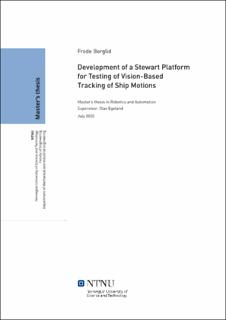| dc.contributor.advisor | Olav, Egeland | |
| dc.contributor.author | Berglid, Frode | |
| dc.date.accessioned | 2021-09-24T18:20:42Z | |
| dc.date.available | 2021-09-24T18:20:42Z | |
| dc.date.issued | 2020 | |
| dc.identifier | no.ntnu:inspera:57228313:20930537 | |
| dc.identifier.uri | https://hdl.handle.net/11250/2781731 | |
| dc.description.abstract | Målet for denne avhandlingen er å utvikle en Stewart Platform til å simulere skipsbevegelser som vil bli brukt til å teste og validere et vision-basert system for sporing av skipsbevegelser til bruk i kranoperasjoner. Målet bak sporingssystemet er å koordinere bevegelser av kranlasta med de bølgeinduserte bevegelsene på destinasjonsskipet, for å oppnå en trygg landing ved flytting av last fra et skip til et annet. Arbeidet vil omfatte produksjon og design av plattformens mekaniske deler, seleksjon og implementasjon av et mekatronikk system og utvikling av et grafisk brukergrensesnitt med visualisering av plattformen, der invers kinematikken må kalkuleres. En ''SBCE'' metodikk vil bli benytta gjennom produktutviklingsfasen. Dette vil tillate mange potensielle løsninger å bli utforsket. Etter en plattform, som har oppnådd de nødvendige krava for det gitte bruksområde, vil fokuset bli endra til et slags for studie, noe som vil gi mer tid til å utforske potensielle forbedringer og nye funksjonaliteter som senere kan bli implementert.
Den ferdigstilte plattformen var i stand til å simulere skipsbevegelser, og var tilstrekkelig til det gitte formål ved å teste det vision-baserte sporings programmet. Likevel var det ønskelig å oppnå mer nøyaktig data av de simulerte skipsbevegelsene. To alternativer for å oppnå dette er diskutert gjennom avhandlinga, og vil enten kreve mer presise aktuatorer, toleranser og kalibrering eller implementasjon av en IMU. Det er konkludert at det ikke er nødvendig å simulere helt nøyaktige båtbevegelser, og det er dermed anbefalt å implementer en IMU. Dette vil være et mye billigere alternativ og kan gi presise data for å ppnå bedre testing og validering av det vision-baserte sporingsprogrammet. Denne løsningen har delvis blitt implementer av plattformens sluttbruker. | |
| dc.description.abstract | This master thesis aims to develop a mechanism to simulate ship motions, which will be used to test and validate a vision-based system for tracking the motion of a target ship for use in crane operations. The purpose behind the tracking system is to coordinate the motion of the crane load with the wave-induced motion of the target ship to have a safe landing when moving a load from one ship to another.
The work will include the design and production of the platform's mechanical parts—selection and implementation of a mechatronic system and development of a graphical user interface with a visualization of the platform where the inverse kinematics is calculated. A SBCE approach will be utilized to explore the solutions space for a potential mechanism, and a functioning prototype will be made. After a minimum viable prototype is achieved, the focus will shift to a pre-study, allowing more time to be allocated to explore potential improvements that can later be implemented. The final prototype was capable of simulating ship motions and could be used for testing of the vision-based tracking software. Nevertheless, it is desirable to get more accurate ground truth data for the pose of the platform. Two alternatives to achieve this are discussed in the thesis, which either requires more precise actuators, components, tolerance for machining and calibration, or an IMU to measure the platform's pose. Since it is concluded that entirely accurate motion is not necessary to test and validate the tracking software, an IMU is recommended since it will be an order of magnitudes cheaper than developing or purchasing a precise platform. An IMU is also already partly implemented by the end-user. | |
| dc.language | | |
| dc.publisher | NTNU | |
| dc.title | Development of a Stewart Platform
for Testing of Vision-Based
Tracking of Ship Motions | |
| dc.type | Master thesis | |
